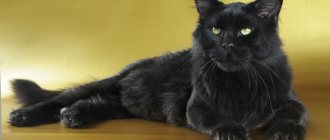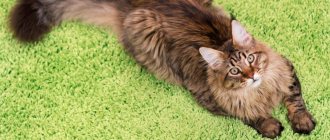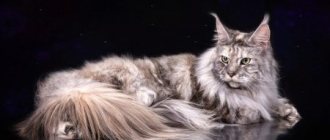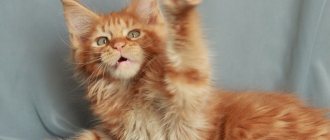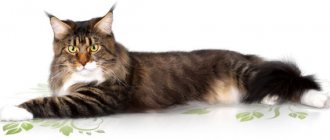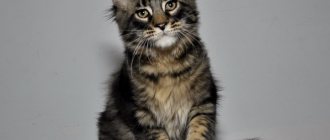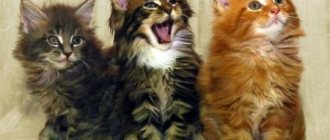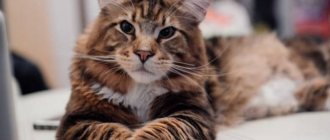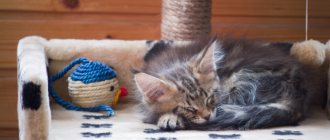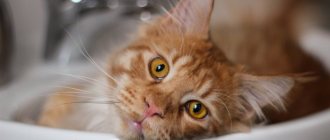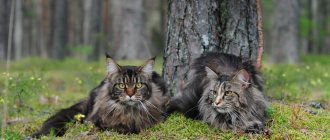Of course, every cat lover and owner has his own preferences regarding the color of his pet’s coat. Some people believe that there is no more attractive cat than the owner of a white fur coat, some prefer fiery red cats, others see beauty in striped fur. The only thing that almost everyone will agree with is that Maine Coons with black coats are especially attractive. Perhaps it’s the timeless classic or the fact that there is something mystical and mysterious about black cats.
Tabby (Tabbies)
If your cat has stripes on his coat, then the color of this Maine Coon is called “tabby” or “brindle”. All tabbies have thin lines on their muzzle that expressively outline their eyes, and on their forehead lines that form the letter “M.” If you look at the fur close up, you will notice that each hair is colored with dark and light stripes. This alternation is called "Agouti". It is commonly believed that tabby is the original color of wild cats.
There are four main tabby patterns:
Mackerel tabby (brindle)
- a pattern in the form of parallel vertical stripes.
Classic tabby (classic)
- wide spiral stripes on the sides, reminiscent of marble stains. In the UK this pattern is called "blotched tabby".
Spotted tabby - (spotted).
Spots throughout the body in the form of intermittent stripes.
Ticked tabby
- sometimes called Abyssinian or agouti. Without stripes or spots on the body, but with a pattern on the face and agouti on the body. This color is typical for Abyssinian cats, but it also occurs in other cats. Ticked colors are not recognized in the Maine Coon breed.
Tabbies come in a wide variety of colors. Tabby color refers to the color of the stripes or the tip of the tail. The main color of agouti varies from faded blue to deep red.
Maine Coon cat, black silver tabby color ns 22
Maine Coon cat red silver tabby ds 22
Maine Coon cat, cream tabby color MCO e 22
Maine Coon cat color black tabby with white (black classic tabby with white) n 09 22
Maine Coon cat, black tabby color (black-classic-tabby) MCO n 22
Maine Coon cat brown mackerel tabby
Maine Coon cat color brown spotted with white (brown mackerel spotted / white) f 09 24
Maine Coon cat brown tabby color
Types of Maine Coon colors: description with photographs
Popular colors for Maine Coon cats are black and red. There are also many other colors. Let's figure out how to distinguish colors and who is a white Maine Coon?
EMS color code
To simplify the names when entering data into documents, the EMS (Easy Mind System) coding system was adopted.
Maine Coon (MC) cats are classified as semi-longhair (SLH – Semilonghair, group 2).
When determining color, three factors are taken into account:
- Coat color
- White spot
- Type of drawing
Coat color is indicated in Latin letters:
White spotting is designated by the following code:
01 – van (almost white individual with several spots) 02 – harlequin (larger colored spots are located on the main white background) 03 – bicolor or two-color 09 – white spots on the legs and/or chest
Other codes do not apply to the Maine Coon breed.
The pattern of a cat is called tabby. Its type is indicated by numbers:
11 – shaded (only 1/4 of the hair is dyed) 12 – chinchilla (only 1/8 of the hair is dyed) 21 – agouti (the coding is assigned if it is clear that the pattern will be, but it is not yet clear which one) 22 – marbled or classic pattern 23 – brindle pattern 24 – spotted pattern 25 – ticked pattern
Maine Coons are allowed to have any eye color that matches the following colors:
61 – blue* 62 – all shades of yellow 63 – eyes of different colors 64 – green
*only white cats have blue eyes
Color classification
All colors of Maine Coon cats can be divided into categories: with a pattern or tabby; without a pattern or solid; tortoiseshell; smoky and silver.
Drawing (tabby)
The Maine Coon Tabby has the following traits:
- stripes on the forehead in the shape of the letter "M"
- eyes and nose mirror are outlined in dark
- there are dark stripes on the sides of the muzzle
- stripes on the chest form a “necklace”
- horizontal stripes on paws
- small spots on the belly
The drawing itself comes in 4 types:
- Marble or classic (blotched/classic). There are rounded marks on the sides; a “butterfly” is possible between the shoulder blades. And solid lines along the spine.
- Tiger (mackerel). There are solid vertical stripes on the sides and a dark stripe along the spine.
- Spotted. Pattern in the form of small spots or dotted stripes.
- Ticked. The drawing is only on the face. Each hair ends in a dark color. The ticked color of Man-Coons is not typical and is typical of Oriental breeds.
People often use the name “wild” or “forest”. Underneath is the black marbled color of the Maine Coon n22.
Solid (solid)
A solid colored cat should have a uniform color throughout the body. Breed standards assume that the coat color is rich and the hairs are dyed from base to tip. The disadvantage is the residual pattern, including on the head, as well as a lighter undercoat (than the main color). Markings of a different color are considered defective.
In Maine Coons, solid is represented by 5 colors:
- Black
- Red
- White
- Blue
- Cream
Some colors are not allowed in the breed standard. The unrecognized colors of the Maine Coon are: gold, chocolate, cinnamon, fawn, lilac and color point.
If a Maine Coon is born black with a white spot, then it is already a bicolor color.
The red color of the Maine Coon includes all shades. Most often you can hear the name red Maine Coon. Due to the strong tabby gene, it is very difficult to achieve the absence of a pattern in a Red Maine Coon. Therefore, it is slightly visible, but still present in the solid.
You can't go past the luxurious white Maine Coon cat. As stated earlier, this color is not a color. This is rather a lack of color in the Maine Coon, because the hair does not have color pigment. A small kitten may have color markings on its face that fade over time. Pets are not fussy to care for. White Maine Coons come with blue eyes and multi-colored eyes (one is blue and the other is green). The completely green iris of the eyes is characteristic of the silver color (description below). It is worth noting that such kittens have a risk of being born deaf. Therefore, it is better to choose a snow-white miracle from experienced breeders: crossing two white individuals is prohibited.
Maine Coons of the blue solid color are not very common in the CIS countries. Their fur is ash-gray in color, with a certain blue tint. Probably because of him, blue Maine Coons became popular in Europe.
The cream Maine Coon is obtained by lightening the red color. The color has warm shades of ginger. Achieving pure colors is problematic due to the progression of classical genes in the Maine Coon.
Tortoiseshell
There is an opinion that cats with a combination of several colors bring good luck. A black tortoiseshell Maine Coon can be a torby or a tortie depending on the number of colors. Torbi includes red and black (brown). Torti adds cream color. The lightened classic tortoiseshell coloring is called blue-cream.
Interesting! Most cats are born with tortoiseshell coloration. The chance of having a boy is 1 in 1000.
Tortoiseshell cats can be additionally smoky or silver.
In addition, the color may be missing or have white markings of varying sizes. A Maine Coon with white spots that have distinct edges is called a calico. Translated as “chintz” or “flap”. Calicos are characterized by the presence of red spots with a pattern. Blue-cream Maine Coons, with a spotted pattern or diluted calico (calico) may also have white markings.
Silver and smoke
Smoky Maine Coons always produce an impressive effect. A distinctive feature of the color is the presence of a perfectly white root zone in the coat. Do not go with a lightened or grayish color.
Smoky coloring has its own categories:
Black Smoke Maine Coons, like Blue Smoke, have a rich base color along with white roots. Tortoiseshell can also be smoky.
If a cat with a white undercoat has a pattern, then this color is called silver. As a rule, such kittens are born very light. As they grow older, the fur begins to darken and the pattern becomes brighter. Coloring is determined at a young age by eye color. The silver color has green eyes, and the blue color has white eyes.
In red smoke (silver) kittens, the coat pigment is weakly visible. They are born light-colored, which is why they are called “cream” or “cameo.”
White spots
White spots can be in addition to the main color. Depending on the size and location, the division occurs:
In conclusion, we can say that Maine Coons do not have rare colors. Even a red Maine Coon or a black merle can be rare if they are unique based on the coloring of their parents. You also need to understand that the same color will look different on two kittens.
Maine Coon color chart or calculator
To understand what color will result from crossing animals, use the Maine Coon color chart.
Solid colors
If a cat is completely the same color, it means it is “solid”. Solid colors were developed due to the suppression of recessive tabby genes. There are cases when the pattern is not completely suppressed, then a fuzzy shadow tabby is noticeable. If you look at a black leopard, you can see the outline of the pattern, since the leopard also has similar suppressed genes.
Cream and red colors cannot suppress tabbies effectively, so the pattern on these animals is always present to a greater or lesser extent. The monochromatic white color is obtained by the action of different genes that completely suppress the color. Many white kittens have vague shades on the head, where the color is not completely suppressed, this goes away with age.
Black MCO n
Blue MCO a
Red MCO d
Cream MCO e
White MCO w
Smoky colors (Smokis)
If the cat is black or blue in color, but the roots of the hairs are clearly white, then it is “smoke”. Solid-colored cats usually have grayish hair roots; true smokes have distinct white roots. Smokes are a solid variant of the silver tabby. This color is very mysterious and impressive, especially in movement with a beautiful play of color.
Smoky colors are divided according to the length of the dyed hair into the following types:
Chinchilla
– 1/8 of the hair tip is dyed.
Shaded
– 1/4 of the end of the hair is dyed.
Smoky
– 1/2 of the end of the hair is dyed.
Black smoke
- black color with white roots.
Blue smoke
– blue color with white roots.
Silver (Shaded/Chinchilla)
- at birth, kittens have fur so light that it appears white. White color can only be inherited from white parents (not silver). A small tabby pattern is sometimes possible at the tip of the tail, which usually disappears by six weeks. A sign that the kitten is silver and not white is green eyes.
Red (cream) shaded or smoky color Cameo (Cameo)
— kittens of this color are usually born white, and tipping appears gradually.
Maine Coon cat, black smoke color MCO ns
Maine Coon cat color blue smoke MCO as
Maine Coon cat, red smoke color MCO ds
Maine Coon coat colors
The content of the article:
Maine Coon color classification
The combination that allows you to describe the appearance of any Maine Coon consists of three components:
- coat tone;
- drawing, its type or absence;
- presence and characteristics of stains.
The main coat color of show standard coons can be one of three shades:
- black;
- red – the common name for “red”;
- white.
Important! Genetically, cats have two coat colors - black and red, white color means the absence of color - the suppression of one of the listed pigments. Kittens born white have dark spots on their heads that disappear with age.
Other variations in coat color are the result of oxidation or lightening of the base shade:
- blue – bleached black;
- cream – clarified red;
- tortoiseshell – black and red (occurs only in cats, not possible in males);
- creamy tortoiseshell blue – bleached tortoiseshell.
The presence of white, that is, the absence of a primary color, is acceptable for any coloring. When the fur and undercoat near the skin are white up to a third of the length, this color in solid-color cats is called “smoky,” and in cats with a pattern it is called “silver.”
All other color options, although they look attractive, are considered unacceptable for purebred cats of this breed.
This is interesting! If it is difficult to determine the color of stripes or spots, you should focus on the tip of the cat's tail.
The pattern on cats' fur is initially present in the form of different stripes, sometimes curls. The absence of a pattern (monochromatic coat color) means that natural striping is genetically suppressed. A single-color kun is called solid (from the English Solid - uniform, integral), in the European version - self (self). Drawings and patterns on the coat are called tabby, this is a genetic gift from wild ancestors.
There are 3 varieties of tabby, characteristic of Maine Coons:
- tiger pattern (Mackerel) – stripes are parallel;
- spotted (Spotted) – the stripes are interrupted and form spots resembling a dotted line or polka dots;
- marble (or classic, Classic) - the pattern twists on the sides in blurry spirals;
The brindle coloring (“mackerel”) on the face, chest and sides is often combined with spotted coloring on the hips. The longer the cat’s fur, the more blurred the tabby looks. The lighter the coat, the more noticeable the tabby.
There is another type of pattern - ticked, in which the tabby is located only on the muzzle, and on the body there are alternating light and dark hairs (agouti) in the coat. This coloring is typical for the Abyssinian breed, but not for Maine Coons.
The spots can be an independent part of the coloring or complement the combination of stripes. Additional elements on a cat’s fur are arranged differently:
- resemblance to the letter “M” on the muzzle;
- lightened back of the ears;
- dark circles around the eyes and nose (“so-called “make-up”);
- darkened stripes on the cheeks;
- "necklaces" around the neck;
- “bracelets” on the paws;
- "buttons" on the abdomen.
This is interesting! In fact, the pattern is present on the coat of any Maine Coon. In those individuals that visually do not have it, it is genetically suppressed and “hidden”, as if under a cloak, under darker fur.
With lighter-colored offspring, the “native” tabby may well be revealed in kittens. Some Maine Coon colors have received their own names.
Solid cats
The solid color of one of the flowers allowed for breeding gives the Solid color. Basic shades alone or in combination with white give several variations of solid coats:
- black solid – uniform dark color, without visible spots and stripes;
- red solid – completely dyed hairs of the same shade (extremely rare, often in combination with white), the pattern is practically invisible, but can barely be visible (shadow tabby);
- cream solid – practically never found without tabby;
- blue solid - a lightened black shade, without a pattern (very popular in the eurozone, not very common in the Russian Federation);
- smoky solid - a black or blue solid Maine Coon has white hair roots.
Colors with white
Any recognized color is complemented by clear white spots of various locations.
Depending on the size and location, there are several varieties of these colors:
- van - a completely white cat has small spots of other shades on the head and tail;
- harlequin - spots on a white background not only on the head and tail, but also on the back of the cat;
- bicolor – half the wool is colored, half is white;
- “gloves” – white fur only on the paws;
- “medallion” – a clear white spot on the chest;
- “buttons” – small white spots on the body;
- “Tuxedo” – white chest and paws.
Colors with smoke
“Smoke” is the name given to the distinct whiteness of the roots of the hairs with a dark, solid color. This is a very beautiful color, creating an impression of mystery, shimmering when the cat moves.
Depending on the length of the white part of the hair, different types of “smokiness” are distinguished:
- chinchilla – almost the entire fiber is white, except for 1/8 of the colored part;
- shaded – the hair is ¾ white;
- smoky – half colored hair, half white;
- black or blue smoke - the corresponding base color with white hair roots;
- silver – almost white, with green eyes (the pattern on the tip of the tail disappears with age);
- Cameo (red or cream smoke) - kittens are born white, then the corresponding color gradually appears on the tips of the hairs (tipping).
Tortoiseshell colors
Cats of this type can have different combinations of colors in the form of spots of any size and shape. It is customary to divide them into two large groups: with or without the presence of white.
Multi-colored Maine Coons without white can have the following color variations:
- “turtle” – spots, clear and/or blurred, located all over the body in a random combination of red, black or cream;
- brown spotted tabby - the color of autumn foliage, a combination of spots and stripes in shades of red and brown;
- cream blue (“dilute tortoiseshell”) - spots of the named pastel shades in different combinations throughout the body;
- blue spotted tabby - soft colors with large patches of cream and blue;
- “smoky” turtle – different colors, white hair roots;
Tortoiseshell shades including white:
- Calico (or “calico”) – a lot of white, spots of red and black, red spots with stripes;
- blue cream with white - a simple tortoiseshell color complemented by small white areas;
- “dilute chintz” - the white background is almost covered with cream spots, complemented by tabby, which are combined with uniform blue ones;
- spotted tabby with white – large and clear white spots on the tabby coat;
- “silver tortoise” – white hair roots in a cat with a tabby and different combinations of spots.
Wild color
Otherwise, this color is also called “black marble”. It most closely conveys the color of the fur of wild relatives of Maine Coons, forest cats (pallas' cats, lynxes, jungle cats), whose color should make them invisible among the branches and foliage.
This is interesting! These animals are not the direct ancestors of the Maine Coons, but in terms of color, the “savage” coons are closest to them.
The only health feature of Maine Coons that is genetically determined by color is deafness or hearing problems in white cats with blue eyes, as well as those with white spots in the ear area. Therefore, breeders prefer to cross white cats with cats of other colors.
With white markings
White markings, clearly defined (as opposed to the shaded spots of the Siamese) can be present on any color. You just need to add “With white (and white)” to the description of the main color. So, for example, you get “Black and White” or “Cream and White”.
The white areas may vary in size and location, and the most accurate name for the color depends on this:
With white medallion (locket)
- There is a white spot on the chest.
With white gloves (mitted)
– white slippers on the paws.
With white buttons
– the presence of one or more small white spots.
Bicolor (bi-color)
– half white.
Harlequin
- white with several large colored spots.
Van
- all white with color on the tail and head.
Tuxedo (tuxedo)
- white paws and chest. May have some white on head. This definition is informal.
Van
Harlequin
Bi-color
Tuxedo (Tuxedo)
With white medallion (Locket)
With white gloves (Mitted)
